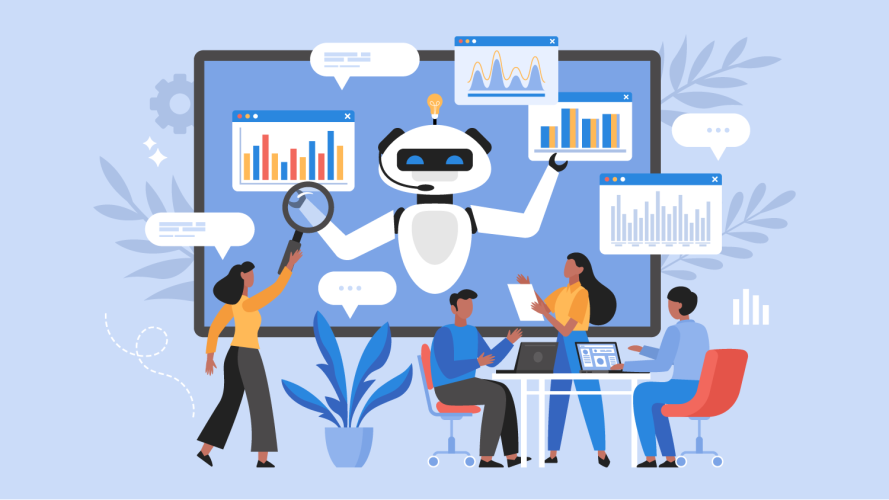A Smarter Way To Predict Cash Flow Led This Company To Adopt AI



Use artificial intelligence to accurately forecast short- and long-term cash flow while being empathetic to your customer's challenges.

Felisa Palagi
This article is contributed by Internet Creations, a professional services organization based in New Jersey, and a Salesforce partner with 11 support agent and sales apps on the AppExchange.
During my career, I’ve learned the value of creating experiences that help keep stress levels down — to anticipate what people may need before they have a problem. When the founder of Internet Creations asked me to take on the role of CEO shortly after COVID-19 hit, I knew this leadership approach would be more important than ever during the crisis. What fears might employees and customers have? How can we proactively solve them?
The pandemic tested me right away. With growing delays in customer payments, it was becoming difficult to forecast our short- and long-term cash flow. We needed a way to keep the business running while also being empathetic to the challenges our customers were facing.
As a company specializing in helping our clients get the full potential out of Salesforce, we also use it to run our business. But up until this point, we had not yet used Salesforce’s artificial intelligence (AI) capabilities. COVID-19 gave us a reason to change that.
AI improves forecast accuracy of cash flow during COVID-19
During my first weeks as CEO, we started using Einstein Prediction Builder to predict late payments, which helped our business and customers take important steps towards recovery.
The pandemic required that we keep a much closer eye on cash flow. In the past, we forecasted cash receivables based on contract terms (e.g., Net 10, Net 30). But with customers struggling to pay on time, that was no longer adequate.
AI gave us a smarter way to predict cash flow. We started with the question: When can we realistically expect to receive payments? We used historical data about how customers paid us in the past, then considered industry and added buffers, such as extending payment time by 30%: if a customer in the travel industry typically pays in 20 days, now we will assume it will be 26 days.
With insight into payment dates, our collections agent was able to proactively reach out to customers with flexible payment options. AI also had an immediate impact on the business, increasing the accuracy of our June cash receivables forecast by nearly two-and-a-half times.
With accurate insight into cash flow, we are better informed about when we can move through stages of recovery, like investing in the next strategic initiative and bringing back employee experiences we put on hold.
4 strategies for effective AI — especially in the midst of change
I’m grateful for my background in change management and crisis management that has helped me lead during this crisis. Whether we were implementing AI in the middle of the pandemic or under less volatile circumstances, I would still rely on these four strategies.
1. Start simple. We decided to start with a very specific need — predicting cash flow. That way, if something were to go wrong, there were only so many data points we needed to look at. Plus, focusing on a very specific use case helped us move quickly. An experienced Salesforce Admin set up Einstein Prediction Builder in less than one hour.
2. Connect AI with human interactions. We already have great relationships with our customers, and AI became the catalyst for deeper connections with them. We were able to better support them as they were figuring out how to manage through COVID-19. It shifted the dynamic from collecting late payments to a far more pleasant conversation of offering help.
3. Build trust in the AI. One important change management function is to run manual analysis in parallel with AI. This gave us confidence that the AI and the inputs were getting set up correctly, but more importantly, it helped to build trust among the users. When people using the AI aren’t the ones calculating the data, it’s common for them to not trust the results. Running manual analysis can help them overcome this fear by showing them where AI may be uncovering new insight they haven’t seen before.
4. Communicate — frequently. Two-way communication is critical, especially in a crisis. We actively sought feedback to hear employees’ fears and frustrations and shared data from the cash flow prediction to give insight into the business’s financial health. These steps empowered the team to lean in. Instead of being scared, they could roll up their sleeves, collaborate, and help make changes.
When people feel taken care of, they’ll get creative and will pivot. 25% of our people have partly or fully transitioned to help in new ways, such as helping our Product Support team manage customer inquiries and working closely with Marketing to publish content that helps other Admins in the Salesforce ecosystem.
Creating customer moments that matter
I’m hypersensitive to making things easier for customers, and I’ve seen the relief they feel knowing we have their back when they are in crisis mode. It’s more than being able to generate revenue; it’s about reducing stress and freeing them up to tackle other priorities.
As we work our way out of COVID-19, I’ll keep looking for ways to create more moments to engage with customers. And AI is an enabler for that.
Partnering with Salesforce has allowed us to continue to experiment with AI. In March, we started using Salesforce Chat and Einstein Bot for our chatbot, which has led to faster response times for our customers. We’re also looking to add AI to our support agent apps on the AppExchange, and expand AI internally to forecast sales, predict lead volume, and support resource planning.
COVID is a marathon, not a sprint. While we had to move quickly, the stakes were too high to take risks or allow for error with manual analysis. AI helped us move swiftly and more confidently so we could get the analysis out of the way and focus on easing employee and customer fears in a time of crisis. AI will continue to update our results to provide critical information as we continue to adjust, improve, and recover.
If you want to learn more from other customers turning to AI to help their business navigate and recover from the crisis, join our Learn AI event.























